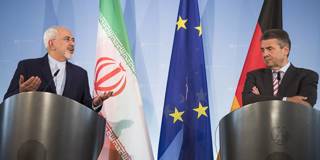The 2015 Joint Comprehensive Plan of Action with Iran is in jeopardy. European governments should use the JCPOA’s dispute-resolution mechanism both to pursue immediate measures to de-escalate regional tensions and to explore a follow-up agreement – or an alternative should the current deal collapse.
BERLIN – When Iran announced in January that it would further “reduce” its commitments under the 2015 deal limiting its nuclear activities, it was not responding to the United States’ assassination of Iranian Quds Force leader General Qassem Suleimani a few days earlier. But both developments reflected the escalating confrontation between Iran and the US since the summer of 2019. Any effort to safeguard the substance of the 2015 deal (formally known as the Joint Comprehensive Plan of Action, or JCPOA) must take this context into consideration.
The Iranian regime declared that with this “fifth and final” phase of scaling back its commitments under the JCPOA, it would no longer feel bound by the deal’s agreed upper limits on centrifuges and uranium enrichment. At the same time, Iran said that this move, as well as its previous phased commitment reductions, is reversible, and that the authorities would not restrict inspections of the country’s nuclear installations by the International Atomic Energy Agency.
But European governments say that Iran’s latest step constitutes a grave violation of the deal. Having warned Iran after its previous round of commitment reductions in November 2019, the “E3” – Germany, France, and the United Kingdom – have now triggered the JCPOA’s dispute-resolution mechanism (DRM), which is designed to deal with possible breaches of the agreement.

BERLIN – When Iran announced in January that it would further “reduce” its commitments under the 2015 deal limiting its nuclear activities, it was not responding to the United States’ assassination of Iranian Quds Force leader General Qassem Suleimani a few days earlier. But both developments reflected the escalating confrontation between Iran and the US since the summer of 2019. Any effort to safeguard the substance of the 2015 deal (formally known as the Joint Comprehensive Plan of Action, or JCPOA) must take this context into consideration.
The Iranian regime declared that with this “fifth and final” phase of scaling back its commitments under the JCPOA, it would no longer feel bound by the deal’s agreed upper limits on centrifuges and uranium enrichment. At the same time, Iran said that this move, as well as its previous phased commitment reductions, is reversible, and that the authorities would not restrict inspections of the country’s nuclear installations by the International Atomic Energy Agency.
But European governments say that Iran’s latest step constitutes a grave violation of the deal. Having warned Iran after its previous round of commitment reductions in November 2019, the “E3” – Germany, France, and the United Kingdom – have now triggered the JCPOA’s dispute-resolution mechanism (DRM), which is designed to deal with possible breaches of the agreement.